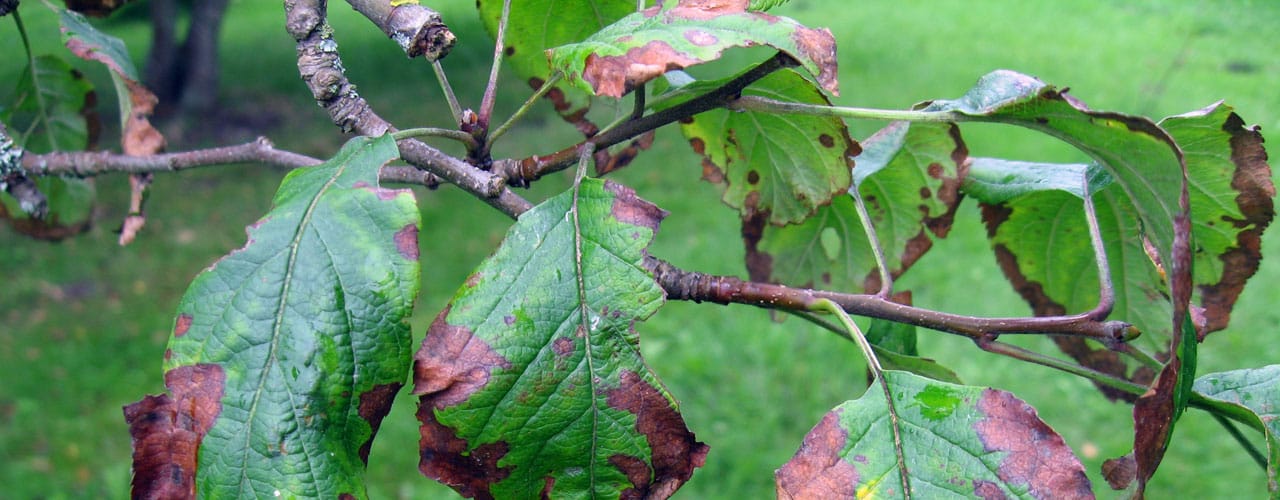5 Worst Tree Diseases in the Dayton Area

While it’s always concerning to see your trees looking “sick,” not all tree diseases in the Dayton area are as damaging as the ones described below. It’s important to know which disease is affecting your trees so you can evaluate the treatment options and learn how to prevent a recurrence.
In this article we share five common diseases that affect trees around Dayton, describe what to look out for, and the trees they typically infect.

Apple Scab
Apple scab is the result of a fungus that causes dark blotches (called lesions) to form on leaves in late spring. Tree leaves turn yellowish (chlorotic) and fall off over the summer, sometimes leaving the tree completely defoliated.
Fruit are also affected by apple scab. They develop circular dark brown spots, become deformed, rot and drop prematurely. A tree infected with apple scab is unlikely to produce an edible harvest.
Besides the aesthetic issues caused by apple scab, it also weakens the tree and makes it more vulnerable to other diseases and pests.
The best treatment for apple scab is a spring fungicide application to reduce the severity of the disease. Infected branches can be pruned out and all fallen fruit and leaves should be disposed of (do not compost diseased debris!). Winter pruning to open up the canopy can also be helpful.
Targets: Apple, crabapple

Cedar-Apple Rust & Hawthorn Rust
These two diseases are very similar and are caused by fungi in the genus Gymnosporangium.
What makes this disease interesting is that the fungus spends part of its life cycle on trees and shrubs of the Juniperus species, such as Eastern red cedar and common juniper. Although it doesn’t kill Juniperus spp., it does cause galls to form on small branches, followed by bright orange tentacle-like spore horns during wet conditions in late spring.
The leaves on deciduous trees infected with this disease develop yellow spots with a darker orangish center shortly after spring flower bloom. Later in the season, you’ll see similar spots and rotted areas on the fruit.
Consider planting trees that are immune or resistant to rust diseases and avoiding planting junipers nearby. Control can be achieved by spraying a fungicide at bud break (usually in mid- to late-April in our area) and then weekly until flower petals fall.
Targets: Apple, flowering crabapple, hawthorn

Rhizosphaera Needlecast
This disease, caused by the fungus Rhizosphaera kalkhoffii, causes needles on spruce trees to drop prematurely. The infection starts on the lower branches and gradually moves up the tree and from the inside out toward the branch tips. If the disease is particularly bad, it can kill the lower tree branches and, over a number of years, can kill the entire tree.
Healthy spruce trees normally keep their needles for 5 to 7 years, but those severely infected with Rhizosphaera needlecast often hold onto only the current year’s needles. Lost needles do not grow back so the tree will look “bare” or spindly.
Infection of new growth happens in May/June, mostly during wet weather when spores are splashed by rain onto newly developing needles. Symptoms don’t become noticeable until infected needles turn brown/purple and begin to – usually the following spring or fall (12 – 15 months after infection).
Stressed trees are more likely to be infected, so ensure that your spruce receive enough water in summer (deep root irrigation is one way to do this) and avoid planting in heavy, compacted soil. Avoid pruning when needles are wet, as that encourages the fungus to spread.
Rhizospaera needlecast can be treated with a spring fungicide application to prevent infection of newly emerging spruce needles. Fungicide treatments are usually applied in early spring (April), mid-spring (early May), and late spring (May/June).
Targets: Spruce, particularly Colorado blue spruce

Diplodia Tip Blight
This common fungal disease, caused by the pathogen Diplodia pinea, kills the tips of pine branches (i.e., new growth). It’s pretty obvious when trees are infected as branch ends turn brown. Over time and with continued or repeated infections, most of the tree branches turn brown, entire branches die, and eventually, the tree can die.
The disease usually begins in spring on new shoots, turning the new needles brown before they are fully formed. From there it can spread down the branch and onto other branches by wind-blown rain, rain splash, certain insects, and infected pruning tools.
Mature trees that have been under stress from drought, root restriction or other planting site problems are at greatest risk of infection. Prevention involves keeping trees in good health through regular maintenance, deep watering during droughts, and controlling insect pests.
If the pine is only lightly diseased, infected branches can be pruned out. Be careful to do so only during dry weather, to disinfect tools between cuts, and dispose of all debris safely.
Diplodia tip blight can be partially controlled by applying a series of fungicide treatments in spring, starting before bud break.
Targets: Pine trees, including Austrian (Pinus nigra), red (P. resinosa), mugo (mugho) (P. mugo), and Scots (Scotch) (P. sylvestris) pines
Image above courtesy of Minnesota Department of Natural Resources , Minnesota Department of Natural Resources, Bugwood.org

Dothistroma Needle Blight
Another fungal disease that infects pines, Dothistroma needle blight causes dying needles on older pine branches, closer to the tree trunk. The infection typically begins in spring when the fungus affects the tree’s lower branches; over time, it gradually moves upward.
Symptoms become visible in late summer or early fall, when you may notice yellowish spots developing on diseased needles. As the disease progresses, the spots darken, enlarge and form bands around the needles, killing the part of the needle above the band. The next spring and summer, those needles will fall off.
As with most fungal diseases, stressed trees are more susceptible to infection. Provide ample water during dry spells, plant trees in well-draining soil and with enough space for good air circulation, engage in regular and professional tree maintenance, and provide necessary insect control.
Fungicide applications are effective for controlling Dothistroma needle blight, provided the first application is made right before bud break (to protect older needles). A second application will occur a month or two later. Repeated treatments may be necessary for several years if the tree is severely diseased.
Targets: The disease is a significant problem on Austrian, red and Scots pine. Other conifers that are reported to be susceptible hosts include Douglas-fir, Sitka spruce and European larch.
For more information about this disease, see our video on Dothistroma Needle Blight.
Summary
If your trees have, or you suspect they have, any of these diseases, please give us a call. We’ll inspect your trees, confirm/make the diagnosis, and recommend an effective treatment. All of these diseases are manageable if they’re identified soon enough.
See when to treat these diseases in Dayton >>
Learn more about our approach to Integrated Pest Management >>
